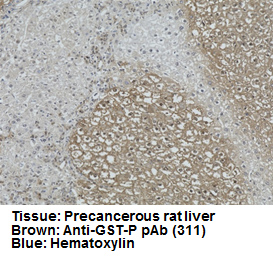- Japan(Japanese / English)
- Global
- MBL TOP
- MBL site search
Close
This site is for customers in Japan.
Customers in other regions, please go to Global page.
HOME >
Product search results > Code No. 311-H
Anti-GST-P pAb
Price
¥32,000
Availability (in Japan)
10 or more
(In Japan at 17:00,
Apr 20, 2024 in JST)
Size
6 mL
| Data | |||||
|---|---|---|---|---|---|
| Clonality | Polyclonal | Clone | Polyclonal | ||
| Isotype (Immunized Animal) | Rabbit IgG | ||||
| Applications | |||||
| Immunogen (Antigen) | purified rat liver glutathione S-transferase P | ||||
| Reactivity [Gene ID] | |||||
| Storage buffer | PBS/2% FCS/0.09% NaN3 | ||||
| Storage temp. | 4°C | Conjugate | Unlabeled | Manufacturer | MBL |
| Background | Placental glutathione S-transferase (GST-P), a member of glutathione S-transferase, is known for its specific expression during rat hepatocarcinogenesis and has been used as a reliable tumor marker for experimental rat hepatocarcinogenesis. | ||||
| Related products | 311 Anti-GST-P pAb 312 Anti-GST-π pAb |
||||
| Citations |
Immunohistochemistry
|
||||
| Product category |
|
||||
- The availability is based on the information in Japan at 17:00, Apr 20, 2024 in JST.
- The special price is shown in red color.
- Please note that products cannot be ordered from this website. To purchase the items listed in this website, please contact us or local distributers.
- Abbreviations for applications:
WB: Western Blotting, IH: Immunohistochemistry, IC: Immunocytochemistry, IP: Immunoprecipitation
FCM: Flow Cytometry, NT: Neutralization, IF: Immunofluorescence, RIP: RNP Immunoprecipitation
ChIP: Chromatin Immunoprecipitation, CoIP: Co-Immunoprecipitation
DB: Dot Blotting, NB: Northern Blotting, RNA FISH: RNA Fluorescence in situ hybridization - For applications and reactivity:
*: The use is reported in a research article (Not tested by MBL). Please check the data sheet for detailed information.
**: The use is reported from the licenser (Under evaluation or not tested by MBL).
- For storage temparature: RT: room temparature
- Please note that products in this website might be changed or discontinued without notification in advance for quality improvement.








 Citations
Citations Data Sheet
Data Sheet


